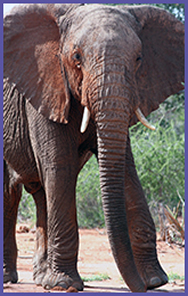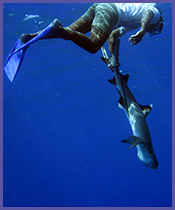


The goal of my research program is to better understand how ecological communities are constructed and how they operate - as well as to determine how these communities interact with one another at the ecosystem level.
I am particularly interested in how body size shapes the ecology of communities and ecosystems. One of the most dramatic anthropogenic impacts on global ecosystems has been the selective reduction and elimination of large-bodied vertebrates. These losses have dramatically reshaped the size structure of many ecological communities – in both contemporary and historical ecological time. I am deeply interested in this phenomenon because it provides a powerful opportunity to examine how the body size of particular species and the size distributions of entire communities influence key properties of ecological function.
My research currently addresses three major questions:
1. How is ecosystem connectivity shaped by community body size distributions?

The largest constituents of ecosystems often range across sizable areas influencing the ecology of these regions at both small and large scales. I am interested in understanding how these connections take shape and better resolving the proximate and emergent dynamics of this special source of connectivity. I have explored these questions in coral reefs using model large consumers such as sharks, bumphead parrotfish, and manta rays. A special focus of this work involves determining how large consumer-mediated connectivity affects fundamental structural properties of communities and key biogeochemical processes of ecosystems. In conceptually related work in East Africa I am working on an NSF-funded collaborative project with researchers at UC Berkeley and Princeton University aimed at understanding how the common hippopotamus shapes the cross-system dynamics of aquatic and terrestrial communities.
2. What are the mechanisms and routes by which change propagates across complex food-webs?

A considerable portion of my research deals with understanding how perturbations travel across ecological systems and alter their function. I am particularly interested in how such systems reorganize following the removal of their largest consumers. My works considers both the lethal and non-lethal repercussions of large animal loss. I have studied the effects of removing large consumers in coral reefs (effects on prey behavior, prey niche architecture, and benthic dynamics) and African savannas (effects on plant dynamics, small mammals, reptiles, and parasite communities). While many of the sources of change originate at the top of food webs – I also am interested in how such top down forces influence basal resource dynamics and thus govern the functioning of whole ecological systems.
3. How does anthropogenic change alter the structural and dynamical properties of communities and ecosystems?

I am interested in how people modify the ecology of ecosystems. One major source of anthropogenic change has been the dramatic restructuring of animal size distributions since the Pleistocene and into the Anthropocene. I am interested in how these shifts alter the living architecture of communities and how these structural changes influence how energy and influence moves within and between ecosystems. My work also confronts how physical shifts in the environment engendered by climate change influence relationships between key biological actors and ecosystem processes (e.g. how climate change alters water cycles and aquatic ecosytems in East Africa). Overall, I believe that in order to properly understand communities and ecosystems in this era of rapid global change we must study ecology in light of human-induced environmental modification
Please learn more about our research on the ecology of fishing in the Line Islands archipelago here.